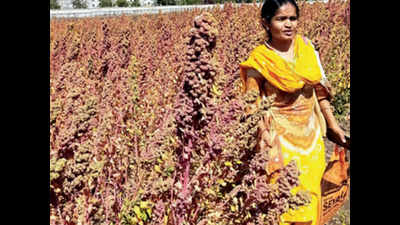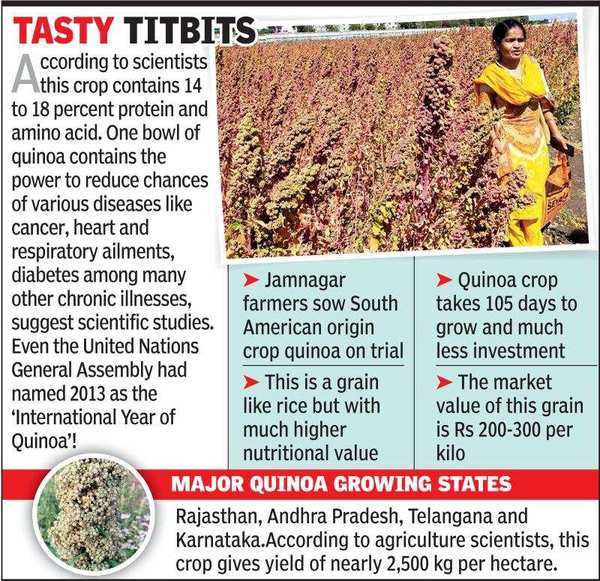- News
- City News
- rajkot News
- Jamnagar’s tryst with wholesome quinoa
Trending
This story is from February 5, 2021
Jamnagar’s tryst with wholesome quinoa
It’s truly a wonder grain — packing in its little self all the right punches from nutrients and proteins to fibre, iron, magnesium, manganese, calcium, B vitamins to beauty-enhancing essentials! No wonder then, that the rich and crunchy edible seed, which has taken palates by storm across the world, has also tickled a motley group of some 20-odd enterprising farmers of Jamnagar district to test their farming skills by raising the earthy versatile food in their own land.

Jamnagar farmers sow South American origin crop quinoa on trial
RAJKOT: It’s truly a wonder grain — packing in its little self all the right punches from nutrients and proteins to fibre, iron, magnesium, manganese, calcium, B vitamins to beauty-enhancing essentials! No wonder then, that the rich and crunchy edible seed, which has taken palates by storm across the world, has also tickled a motley group of some 20-odd enterprising farmers of Jamnagar district to test their farming skills by raising the earthy versatile food in their own land.
In search of an alternate rabi crop, these farmers learnt about this crop from a research station of Junagadh Agriculture University (JAU) based in Jamnagar. And so, South American quinoa (pronounced ‘keen-wa’) was sown alongside the regular rabi staples as an alternative crop. The Gujarati tillers are hopeful of a getting a good yield from their efforts in the coming days.

Quinoa attracted the attention of health conscious urban Indians in metro cities like Mumbai and Bengaluru during the past decade or so. Thanks to its high nutritional value, farming crusader in Jamanagar, Payal Kantariya, a woman farmer of Aarblush village in Lalpur taluka, motivated the other farmers to experiment with the wonder crop this year.
Bariya further said that quinoa, which takes 105 days to mature from sowing is a one-season rabi crop sown in October-November. While its cultivation requires more care, the advantages of the crop include less use of fertilizer, water and only as much as investment required for millets. This crop can grow in dry soil and has been successfully sown in parts of Andhra Pradesh, Telangana, Karnataka and Rajasthan for the past few years.
“I tried last year but wasn’t successful. With JAU guidance I am again experimenting with this crop this year and have enlisted 20 other farmers to join me. I sowed the crop in one Bigha farmland and the plants have gained four to five feet of height. I am hoping for a good yield,” Kantariya told TOI.
According to agriculture scientists, this crop gives yield of nearly 2,500 kg per hectare. Quinoa is sold between Rs 200 and Rs 300 per kilo in the retail market.
Kishor Pedhadiya, an organic farmer of Sumri Dhutarpur village of Jamnagar taluka has sown quinoa for the first time this year. “Looking at the health benefits and good prices in metro cities I have decided to experiment with it this year. I am yet to explore the crop’s market and as this is the first time, I will utilize my first yield for my family and friends. Next year I will try commercially,” he said.
In search of an alternate rabi crop, these farmers learnt about this crop from a research station of Junagadh Agriculture University (JAU) based in Jamnagar. And so, South American quinoa (pronounced ‘keen-wa’) was sown alongside the regular rabi staples as an alternative crop. The Gujarati tillers are hopeful of a getting a good yield from their efforts in the coming days.

Quinoa attracted the attention of health conscious urban Indians in metro cities like Mumbai and Bengaluru during the past decade or so. Thanks to its high nutritional value, farming crusader in Jamanagar, Payal Kantariya, a woman farmer of Aarblush village in Lalpur taluka, motivated the other farmers to experiment with the wonder crop this year.
Talking to TOI, head of Krushi Vigyan Kendra of JAU research station, K P Baraiya said, “I have given quinoa seeds to 20 farmers of Jamnagar, Lalpur and Khambhalia taluka. We had got these seeds from the central government in the millet research centre.”
Bariya further said that quinoa, which takes 105 days to mature from sowing is a one-season rabi crop sown in October-November. While its cultivation requires more care, the advantages of the crop include less use of fertilizer, water and only as much as investment required for millets. This crop can grow in dry soil and has been successfully sown in parts of Andhra Pradesh, Telangana, Karnataka and Rajasthan for the past few years.
“I tried last year but wasn’t successful. With JAU guidance I am again experimenting with this crop this year and have enlisted 20 other farmers to join me. I sowed the crop in one Bigha farmland and the plants have gained four to five feet of height. I am hoping for a good yield,” Kantariya told TOI.
According to agriculture scientists, this crop gives yield of nearly 2,500 kg per hectare. Quinoa is sold between Rs 200 and Rs 300 per kilo in the retail market.
Kishor Pedhadiya, an organic farmer of Sumri Dhutarpur village of Jamnagar taluka has sown quinoa for the first time this year. “Looking at the health benefits and good prices in metro cities I have decided to experiment with it this year. I am yet to explore the crop’s market and as this is the first time, I will utilize my first yield for my family and friends. Next year I will try commercially,” he said.
End of Article
FOLLOW US ON SOCIAL MEDIA










